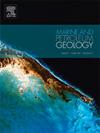The evolution of organic matter sources and sedimentary environments in lakes during the Eocene Climatic Optimum
IF 3.6
2区 地球科学
Q1 GEOSCIENCES, MULTIDISCIPLINARY
引用次数: 0
Abstract
The global climate experienced many rapid and long-term warming events during the early–middle Eocene, and these warming events had a significant impact on the evolution of the global paleoecosystem and led to the widespread development of organic-rich fine-grained sediments worldwide during the same period. To elucidate the regulatory effects of early–middle Eocene warming events on the organic matter (OM) sources and sedimentary environments of paleolakes, in this study, which is based on a detailed analysis of organic petrology, mineralogy, bulk geochemistry and biomarkers of typical wells, combined with a previous understanding of paleoclimate and hydrothermal activities, the influences of warming events on the OM sources and sedimentary environments of early–middle Eocene lakes were systematically investigated. The results demonstrate that units I and III, which were deposited under warm and humid climates, experienced massive freshwater influxes, highstand lacustrine conditions, and dysoxic–anoxic bottom waters, fostering the codominance of algae and terrestrial vascular plants. In contrast, units II and IV record lacustrine salinization events under warm semiarid–semihumid climates and synsedimentary hydrothermal activity, marked by increased salt-tolerant/thiophilic bacteria and euxinic bottom conditions linked to salinity stratification and hydrothermal sulfur cycling. The climatic transition from warm–humid to hyperthermic and semihumid–semiarid conditions during deposition of the Wenchang Formation triggered the amplification of lacustrine biodiversity and expansion of the oxygen minimum zone. Salinization-driven ecosystem restructuring, coupled with elevated primary productivity and exceptional preservation, resulted in organic-rich mudstones with high hydrocarbon generation potential. This study fully reveals the effects of paleoclimate fluctuations during warm periods on the evolution of the ecological environment of paleolakes, thus providing key geological information for deciphering the OM enrichment mechanism in early–middle Eocene paleolakes.
始新世气候最适期湖泊有机质来源与沉积环境演化
始新世早期至中期,全球气候经历了多次快速而长期的变暖事件,这些变暖事件对全球古生态系统的演化产生了重大影响,并导致全球范围内富有机物细粒沉积物的广泛发育。为了阐明始新世早期-中期变暖事件对古湖泊有机质来源和沉积环境的调控作用,本文通过对典型井的有机岩石学、矿物学、整体地球化学和生物标志物的详细分析,结合前人对古气候和热液活动的认识,系统研究了变暖事件对早-中始新世湖泊有机质来源和沉积环境的影响。结果表明,在温暖湿润的气候条件下沉积的单元I和单元III,经历了大量的淡水流入,高水位湖泊条件和缺氧的底水,促进了藻类和陆生维管植物的共优势。相比之下,单元II和单元IV记录了温暖的半干旱-半湿润气候和同沉积热液活动下的湖泊盐渍化事件,其标志是耐盐/嗜硫细菌的增加,以及与盐度分层和热液硫循环有关的缺氧底部条件。文昌组沉积时期由温湿气候向高温气候和半湿半干旱气候过渡,引发了湖泊生物多样性的扩大和氧最小带的扩大。盐碱化驱动的生态系统重构,加上初级生产力的提高和特殊的保存,形成了富含有机物的泥岩,具有很高的生烃潜力。本研究充分揭示了暖期古气候波动对古湖泊生态环境演化的影响,为破译早-中始新世古湖泊OM富集机制提供了关键地质信息。
本文章由计算机程序翻译,如有差异,请以英文原文为准。
求助全文
约1分钟内获得全文
求助全文
来源期刊

Marine and Petroleum Geology
地学-地球科学综合
CiteScore
8.80
自引率
14.30%
发文量
475
审稿时长
63 days
期刊介绍:
Marine and Petroleum Geology is the pre-eminent international forum for the exchange of multidisciplinary concepts, interpretations and techniques for all concerned with marine and petroleum geology in industry, government and academia. Rapid bimonthly publication allows early communications of papers or short communications to the geoscience community.
Marine and Petroleum Geology is essential reading for geologists, geophysicists and explorationists in industry, government and academia working in the following areas: marine geology; basin analysis and evaluation; organic geochemistry; reserve/resource estimation; seismic stratigraphy; thermal models of basic evolution; sedimentary geology; continental margins; geophysical interpretation; structural geology/tectonics; formation evaluation techniques; well logging.
 求助内容:
求助内容: 应助结果提醒方式:
应助结果提醒方式:


